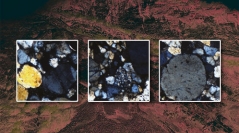

 Geodiversitas
43 (18) - Pages 663-682
Geodiversitas
43 (18) - Pages 663-682The sedimentary strata were sampled in the lesser Himalayas to probe paleoenvironmental changes across the Cretaceous-Paleogene (K-Pg) boundary in the eastern Tethys. The study provides an integrated lithologic and bio-sequence stratigraphic analysis, leading to paleoecology and paleoenvironmental interpretations. The planktic foraminiferal limestone of the late Cretaceous is overlain by lateritic sandstones and sandy foraminiferal limestones, the latter being of Paleocene age. Though the deposition of cretaceous strata mainly occurred in transgressive and high stand system tracts, the top of cretaceous is marked by type-I sequence boundary and low stand system tract, corresponding to the Paleocene Hangu Formation. Deposits below the K-Pg boundary zone interval have been correlated to the late Cenomanian Rotalipora reichel biozone to early Campanian Globotruncana ventricosa zone, with absence of Maastrichtian fauna. A marked change in fauna above the K-Pg boundary zone interval has been observed and manifested by presence of larger benthic foraminifera such as Lockhartia Davies, 1932 and Globanomalina Haque, 1956 genera. The boundary occurs at the contrasting inter-facial contact of the two rock units and advocates an early lowered sea-levels or dead ocean model. An organic bed of late Turonian-early Coniacian corresponds to the probable presence of the OAE3 and could represent a missing link in the late Cretaceous of lesser Himalayas in the Pakistani domain. Prior to the K-Pg event and Indo-Eurasian collision, an influx of siliciclastics suggests a major episode of uplift and shortening caused by ophiolite obduction or magmatic upwelling during the Campanian. The subsequent erosion and its re-deposition shaped the platform, evolving it from relatively steeper ramp geometry in the Campanian to gentler epeiric ramp in the Selandian and Thanetian, and triggered deposition of shallow ramp larger benthic foraminiferal facies. The boundary is similar in nature with erosional phase in the whole region but its duration was prolonged in the study section and its upper limit has some regional changes. As finding of this study, the late Cretaceous “Nara Sandstone Member” of the Kawagarh Formation in Hazara area of earlier workers could be revised as Paleocene Hangu Formation.
Cretaceous-Paleogene, Tethys, Lesser Himalayas, Kawagarh Formation, Foraminifera, OAE3